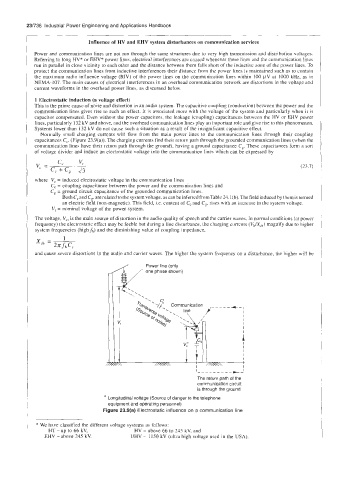Page 779 - Industrial Power Engineering and Applications Handbook
P. 779
23/736 Industrial Power Engineering and Applications Handbook
Influence of HV and EHV system disturbances on communication services
Power and communication lines are not run through the same structures due to very high transmission and distribution vol~ages.
Referring to long HV” or EHV* power lines, electrical interferences are caused whenever these lines and the communication lines
run in parallel in close vicinity to each other and the distance between them falls short of the inductive zone of the power lines. To
protect the communication lines from inductive interferences their distance from the power lines is maintained such as to contain
the maximum radio influence voltage (RIV) of the power lines on the communication lines within 100 pV at 1000 kHz, as in
NEMA-107. The main causes of electrical interferences in an overhead communication network are distortions in the voltage and
current waveforms in the overhead power lines, as discussed below.
1 Electrostatic induction (a voltage effect)
This is the prime cause of noise and distortion in an audio system. The capacitive coupling (conduction) betwccn the power and the
communication lines gives rise to such an effect. It is associated more with the voltage of the system and particularly when it is
capacitor compensated. Even without the power capacitors, the leakage (coupling) capacitances between the HV or EHV power
lines, particularly 132 kV and above, and the overhead communication lines play an important role and give rise to this phenomenon.
Systems lower than 132 kV do not cause such a situation as a result of the insignificant capacitive effect.
Normally amall charging currents will flow from the main power lines to the communication lines through their coupling
capacitances C,, (Figure 23.9(a)). The charging currents find their return path through the grounded communication lines (when the
communication lines have their return path through the ground), having a ground capacitance C,. These capacitances form a sort
of voltage divider and induce an electrostatic voltage into the communication lines which can be expressed by
(23.7)
where V, = induced electrostatic voltage in the communication lines
C, = coupling capacitance between the power and the communication lines and
C, = ground circuit capacitance of the grounded communication lines.
Both C, and C,, are related to the system voltage, as can be inferred from Table 24.1(b). The field induced by them is termed
an electric field (non-magnetic). This field, i.e. content of C, and C,, rises with an increase in the system voltage.
V, = nominal voltage of the power system.
The voltage, V,, is the main source of distortion in the audio quality of speech and the carrier waves. In normal conditions (at power
frequency) the electrostatic effect may be feeble but during a line disturbance, the charging currents (V,,/Xch) magnify due to higher
system frequencies (highfh) and the diminishing value of coupling impedance,
1
x,, = -
2Zfh cc
and cause severe distortions in the audio and carrier waves. The higher the system frequency on a disturbnnce, the higher will be
Power line (only
4 phase shown)
/-one
./lr, Communication i- - - -
x,, line - - - 1
1
-‘
1- - - - - - - - - 1c
The return path of the
communication circuit
is through the ground
* Longitudinal voltage (Source of danger to the telephone
equipment and operating personnel)
Figure 23.9(a) Electrostatic influence on a communication line
* We have classified the different voltage systems as follows:
HT - up to 66 kV, HV - above 66 to 245 kV, and
EHV - above 245 kV. UHV - 1150 kV (ultra high voltage used in the USA)

